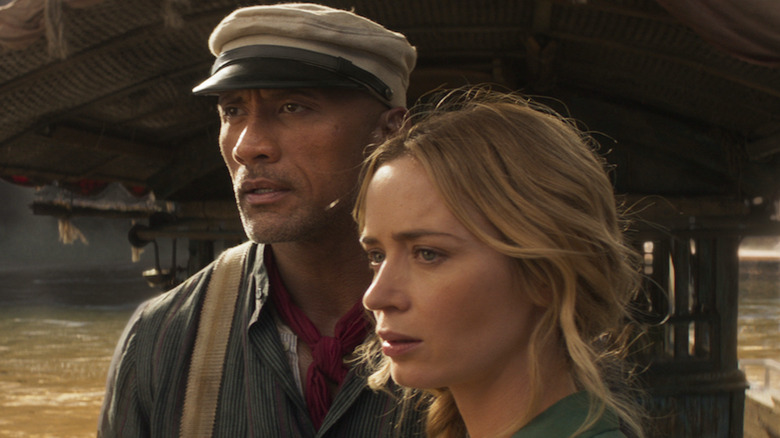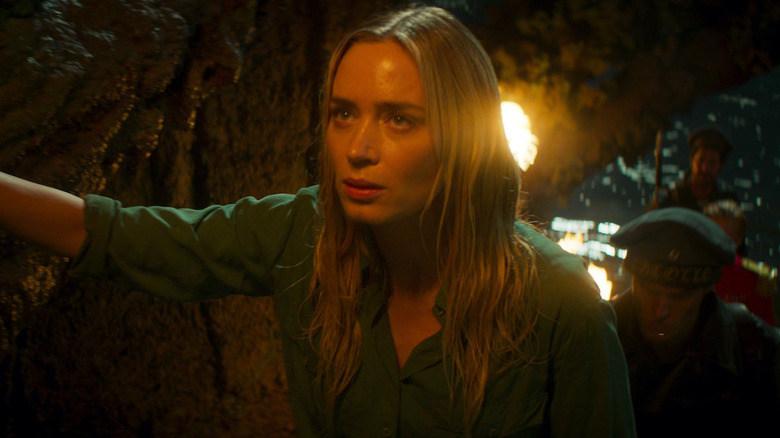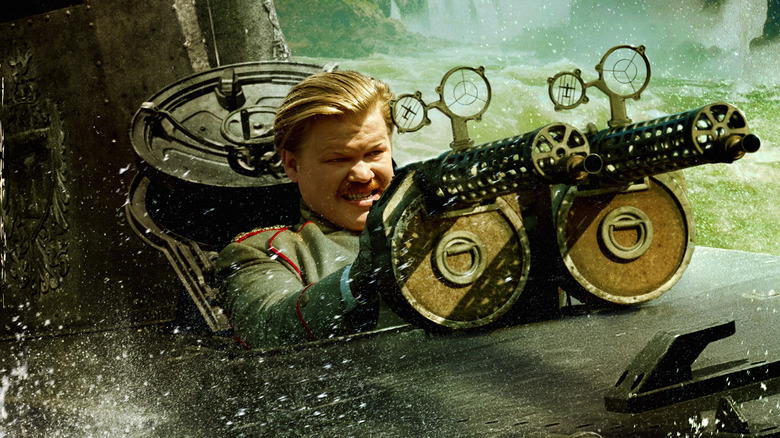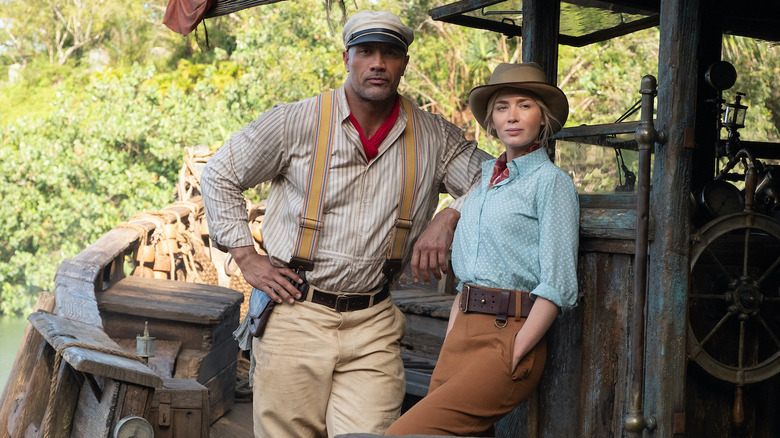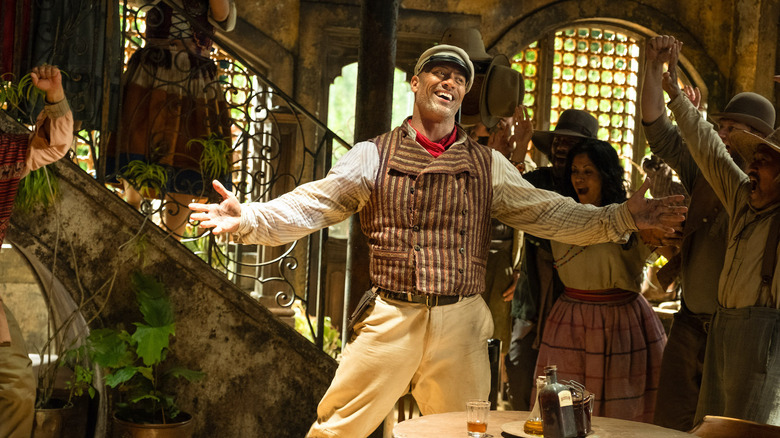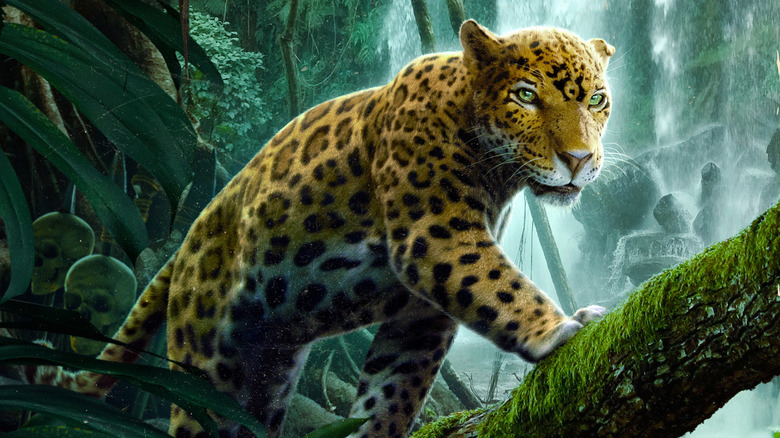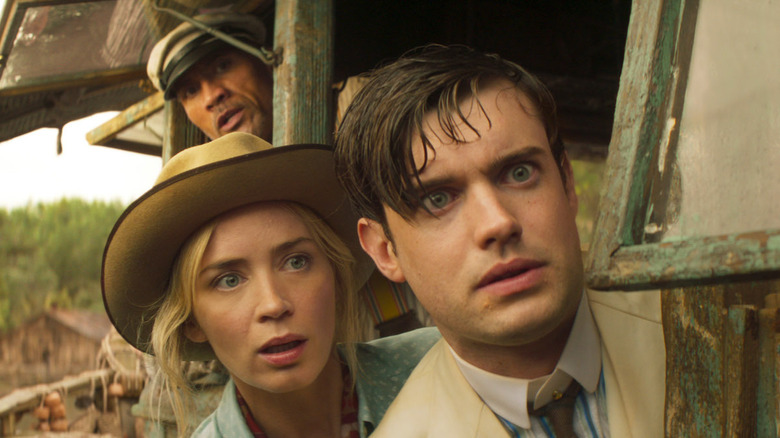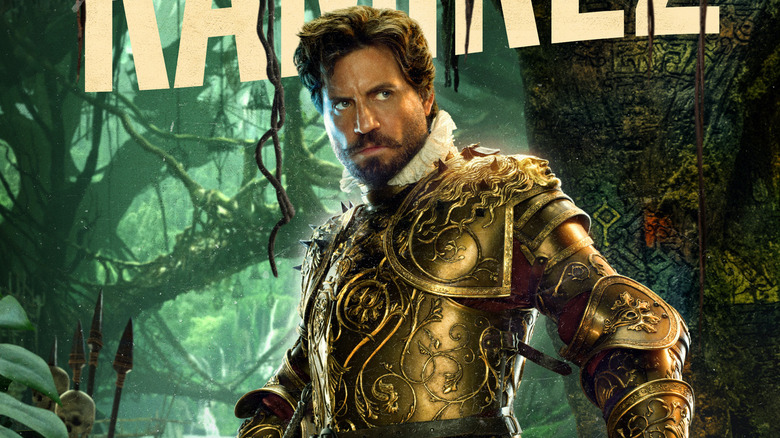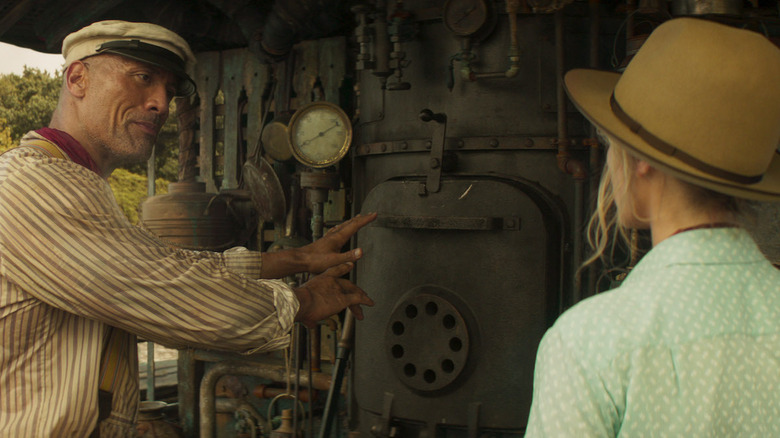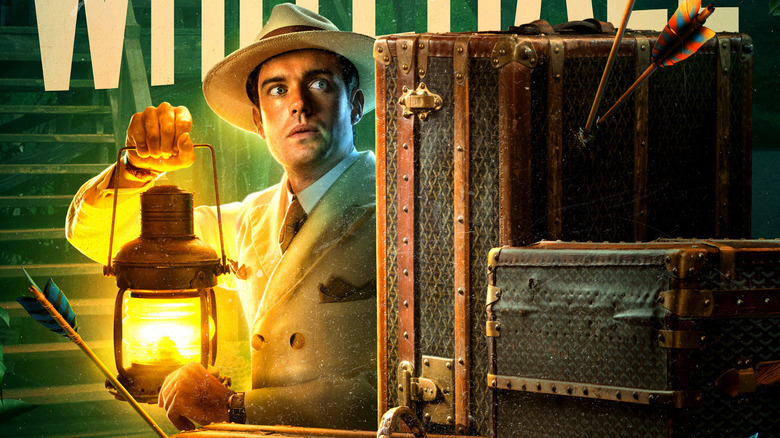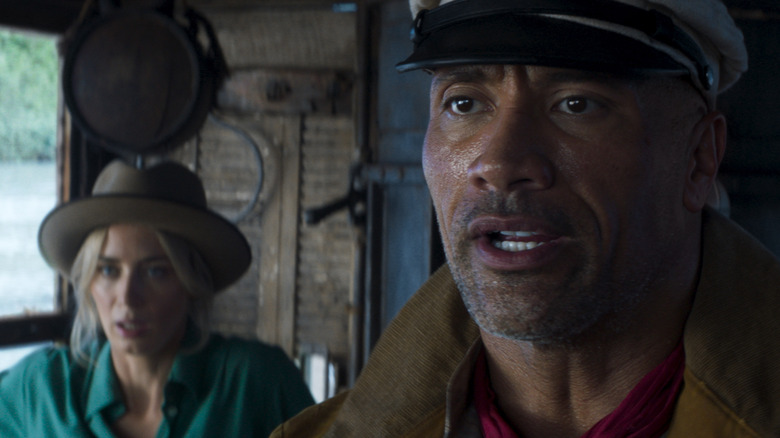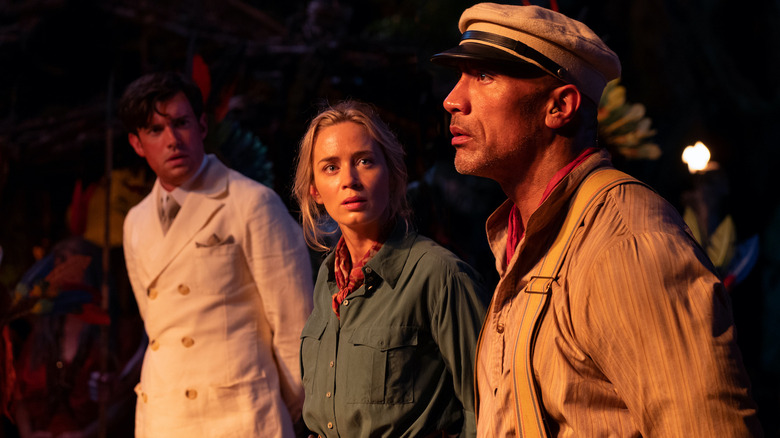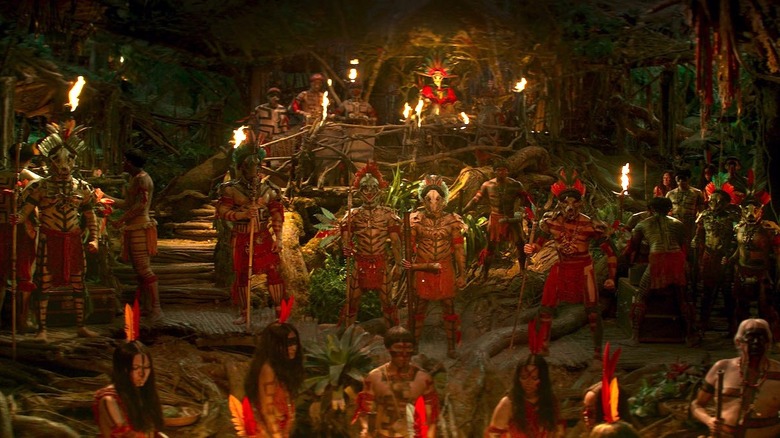Things Only Adults Notice In Jungle Cruise
When Disney theme park fans think "Jungle Cruise," they think riding around in boats, fascinating animals, and punny dad-jokes galore. All that can be found in Disney's new film based on the ride, but there's also much, much more. The ride fans know and love has been transformed into a World War I-set adventure starring Dwayne Johnson and Emily Blunt. With a plot full of action, romance, and humor, the movie is a trip into the unknown as Blunt's character, Dr. Lily Houghton, and her brother MacGregor (Jack Whitehall) enlist Johnson's Frank Wolff to take them up the Amazon River in his ramshackle boat so they can find a legendary tree with miraculous healing powers called the Tears of the Moon.
Given the story's spirit of adventure and jungle setting, there's plenty for both adults and kids to enjoy in "Jungle Cruise." However, with references to everything from old movies to obscure animals and early 20th century history, there are also several elements that are bound to go over children's heads even as adults nod knowingly or perhaps scratch their heads in bemusement. Here is our list of things only adults are likely to notice in "Jungle Cruise." But caution — there are major spoilers for the movie ahead!
The score features a famous power ballad
Adults who remember the music of the early 1990s will be surprised when they immediately recognize the first few notes of the ballad that opens "Jungle Cruise." No, that song wasn't composed specifically for the film, it's the instrumental to power ballad "Nothing Else Matters," which was released by Metallica in 1991 and has since become a staple of the band's live shows and one of its most recognizable songs. According to the credits of "Jungle Cruise," Metallica reimagined "Nothing Else Matters" with the film's composer James Newton Howard, and the four current members of the band, James Hetfield, Lars Ulrich, Kirk Hammett, and Robert Trujillo, are listed as featured performers on the movie's version of the song.
The ballad's haunting, melancholy quality makes it especially recognizable, and while the melody is lovely, it's not clear why Howard decided to feature an orchestral version of a hit from the '90s in the film. In fact, for those in the know, the inclusion of "Nothing Else Matters" may be downright distracting, especially given the movie takes place in 1916 and otherwise features an entirely original score. On the other hand, it could also serve as a good excuse to introduce kids to Metallica.
There are numerous historical references
From a bus full of soldiers to German U-Boats, historical references abound in "Jungle Cruise." However, unless they're history buffs, kids are unlikely to be familiar with the film's numerous nods to World War I. After all, while World War II's Nazis remain popular film and TV villains, it's much rarer for Germans from World War I to be a story's antagonist, as is the case with Jesse Plemons' villainous Prince Joachim in "Jungle Cruise." However, most adults will understand the title card that identifies the setting as "London, England 1916, Two years into the Great War" means the film takes place during the first World War, and that part of Lily and MacGregor Houghton's argument for going after the Tears of the Moon is that it could revolutionize medicine by healing British and other Allied soldiers, who were even more likely to die of disease in the trenches than they were to be killed by the Germans.
The film also references Kaiser Wilhelm II, the last emperor of Germany, who abdicated his throne upon losing the war in 1918. However, even adults may not know that Wilhelm's youngest son really was named Joachim. The submarine that the "Jungle Cruise" version of Joachim travels in will be more familiar, however, as U-Boats are infamous for their use by Germany in both world wars. As far as we know, though, the real-life Prince Joachim never took a U-Boat up the Amazon to search for a legendary tree.
The film leans hard into the gender politics of its time period setting
Throughout the movie, Lily encounters overt sexism. She's first introduced in the balcony of a theater where her brother is presenting a speech she clearly wrote to an academic guild made up entirely of men. And even though she has a Ph.D., her knowledge and abilities are often questioned, as is her resolve to go after the Tears of the Moon. Even her brother worries about who would take care of her if she went to the Amazon alone, although she's clearly more than capable of taking care of herself.
In addition, her choice to wear pants, a rarity in 1916, is called out repeatedly, to the point where Frank even gives her the nickname "Pants" because he finds her choice so exceptional, while completely ignoring the obvious practicalities of wearing pants instead of a dress on an expedition in the Amazon. Kids who've been raised to believe that all genders should be treated equally may be surprised by the treatment the obviously smart and determined Lily endures. Adults, however, will know that in the early 20th century, discrimination against women was much more accepted than it is today, and will understand that her gender makes her something of an underdog in the story.
A jaguar is unlikely to attack unprovoked
Soon after Frank and Lily first meet, Frank is revealed to have lied to her about his true identity. However, he regains her confidence when he goes up against a jaguar who menaces the patrons at the restaurant where they're dining. After all, if Frank can take on a jaguar, he's certainly capable of taking her up the Amazon. However, Lily missed one thing: Jaguars and other animals are unlikely to attack humans unless they've been directly threatened, which this jaguar clearly was not. As a result, many adults in the audience may realize that since the jaguar wasn't acting in self-defense, it's unclear why it came into the restaurant, much less attacked the large gathering of people there.
Given the fear and adrenaline Lily might have felt in that moment, she seems to have failed to notice that given those variables, while Frank's ability to wrestle the jaguar seemed impressive, something else was clearly going on. And indeed, the movie soon reveals that Frank and the jaguar, who's named Proxima, are in cahoots; Proxima attacked Frank in order to secure him the job as Lily's skipper.
Jaguars don't understand English (or any other language)
Proxima the jaguar ends up becoming one of the major protagonists in "Jungle Cruise." It turns out she's actually Frank's pet, and she seems to relate to him and understand what he says almost like a human would. Yet, although kids and adults are used to anthropomorphized animals in children's entertainment, adults will recognize that wild animals should never be pets. Plus, even though the family dog may have a tacit understanding of human language, it's unlikely a jaguar or other wild animal would be able to relate to a human the way Proxima can.
Later in the film, when Frank explains how he came to take in Proxima, he notes that over the years he's adopted "strays" from the Amazon jungle, but this ignores the fact that wild and domesticated animals don't have the same needs. While dogs and cats without owners are considered strays, wild animals like jaguars are not. So Frank could certainly help an orphaned jaguar cub by caring for it, and it might then be impossible to return the cat to the wild because it hasn't acquired the skills necessary to survive. One thing that jaguar will never be, however, is domesticated. As a result, Proxima may provide a good example for parents who want to teach their children about the differences between domestic and wild animals.
The dolphins the characters encounter are a real species
Early in their trip down the Amazon, Frank's boat La Quila sails past a pod of long-peaked dolphins that bears little resemblance to the bottlenose dolphins many people are most familiar with. However, adults may be aware that there are numerous dolphin species, and one of them is the Amazon river dolphin shown in the movie. This freshwater dolphin is native to the Amazon and also goes by the names pink river dolphin — due to its pinkish hue — and, in Brazil, boto cor-de rosa.
In the movie, Lily refers to the dolphins by their scientific name, inia geoffrensis. Meanwhile, Frank's identification of them as "encantado" evokes a myth about Amazon river dolphins being shape-shifters, but more broadly refers to the many legends surrounding the species, including the one Frank relates: that looking into a pink river dolphins' eyes will lead to a lifetime of nightmares.
The film's mythology is a retread of Pirates of the Caribbean
Almost 20 years ago, another movie inspired by a boat-based Disney theme park ride premiered: "Pirates of the Caribbean: The Curse of the Black Pearl." While many younger children are unlikely to have seen that 2003 film, adults may get a sense of deja vu when watching "Jungle Cruise" due to the fact that the film's supernatural storyline largely overlaps with that of the earlier movie. Much like the pirates who were cursed with eternal life after they took the wrong treasure, the conquistadors who went after the Tears of the Moon in "Jungle Cruise" were cursed with eternal life for attempting to take that treasure. Inevitably, just like Captain Barbossa and his crew in "Pirates," Aguirre (Edgar Ramirez) and his allies wish to break their immortal bonds.
If that weren't enough, the mid-movie revelation that Frank himself is also cursed with unending life because 400 years ago he was Aguirre's map maker parallels the eventual revelation in "Pirates" that Jack Sparrow is undead because he was the captain of the Black Pearl before Barbossa and his crew mutinied. The resemblance between the "Jungle Cruise" and "Pirates" mythology may raise some adults' eyebrows, not to mention make them wonder why the powers that be at Disney felt the need to include a supernatural plotline in a film based on a ride that, unlike "Pirates," never included anything that could be interpreted as supernatural.
The African Queen connection
"Jungle Cruise" nods to several well-known films that only adults are likely to notice. In addition to "Pirates of the Caribbean," there are hat tips to 1999's "The Mummy," the "Indiana Jones" films, and "Romancing the Stone." However, if there's one classic that especially influenced the new film, it's 1951's "The African Queen." Theme park buffs will know the "Jungle Cruise" homage to the Humphrey Bogart and Katharine Hepburn-led classic is no accident; Walt Disney was partially inspired to create the Jungle Cruise attraction in Disneyland by "The African Queen."
Given that connection, it's not surprising that the new movie bears a noticeable resemblance to the older film. Both have a plot that revolves around a skipper becoming involved with a brother and sister who require passage down a waterway during World War I. "The African Queen" influence can also be seen in the dynamic between Frank and Lily, who constantly butt heads only to come to respect and then fall for one another, just like Bogart and Hepburn's characters. Adults who notice the connection between the two films may use it as an opportunity to introduce their kids to the 1951 classic.
There's a gay character
While Disney has attempted to be more inclusive by incorporating more openly gay characters in films like the live-action remakes of "Beauty and the Beast" and "Cruella," it's done so in such a subtle way, it's managed to please neither those who want more representation in films nor those who don't. Unfortunately, "Jungle Cruise" has the same issue. The film includes perhaps the most overtly "out" character yet in the form of Lily's clothes-obsessed brother, MacGregor. However, it tiptoes lightly around the issue.
Toward the middle of the film, MacGregor confesses to Frank that although he doesn't share his sister's belief in the legend of the Tears of the Moon, he sticks by Lily because unlike everyone else in his life, she didn't abandon him when she learned about his sexuality. However, although adults will pick up on what MacGregor's saying, his wording is vague enough that many kids are unlikely to realize precisely what he means.
That's not a kiss, it's a lifeline!
In the film's third act, Lily is forced to swim for the first time after Frank finds an underwater chamber with a lever in it that will lead them to the Tears of the Moon. What kids and even some adults may not realize is that when Frank kisses Lily for the first time while she's trapped underwater, it's not for any romantic reason. After all, given the pair's will-they-or-won't-they dynamic throughout the story, the kiss can easily be interpreted as the characters finally admitting their feelings for one another.
However, that's not Frank's intention. As he pantomimes, he's simply trying to provide Lily with air so she can stay underwater long enough to pull the chamber's lever. Of course, even adults would be justified in interpreting Frank as having something of an ulterior motive here, especially since the exchange of oxygen between the characters looks more like a smooch than mouth-to-mouth resuscitation.
There are plenty of references to the Disney theme park ride
Kids who've been lucky enough to visit a Disney park may pick up on some of the film's direct references to the Jungle Cruise ride. When Frank goes under a makeshift waterfall early in the film and triumphantly introduces "the backside of water" with a declaration that it's "the eighth wonder of the world," everyone familiar with the ride will smile knowingly. However, there are some less obvious nods to the attraction that kids may miss, including a shocking number of ridiculous new puns and an early reference to Dr. Albert Falls, the man the ride's waterfall is supposedly named after.
Plus, when Frank is first introduced guiding a jungle cruise of tourists down the Amazon, he essentially functions as a skipper in the theme park ride. As his boat continues along the water, it's revealed that Frank has rigged up his own makeshift Jungle Cruise attraction, complete with a fake hippo, in order to provide the same thrilling — and silly — experience as the ride Disney Parks fans adore.
Some of the nods to the ride are already outdated
Interestingly, after delays due to the coronavirus pandemic, "Jungle Cruise" is hitting theaters just as Disneyland opens an updated version of the ride, and the revised experience no longer includes characters that are featured in the film. After years of complaints over the attraction's depictions of native people, Disneyland removed some of the animatronic characters that appear toward the end of the ride, including Trader Sam, who is willing to exchange "two of his [shrunken heads] for one of yours," and a group of headhunters who are characterized as savages and throw spears at the ride vehicle.
Yet "Jungle Cruise" features both Trader Sam (who's been gender-swapped) and a group of supposedly threatening Indigenous people. While the story avoids shading into racism by revealing that the natives' behavior is all just part of a scheme cooked up with Frank to make his jungle cruises more exciting, adults who keep up on Disney parks news will know that these references to the ride are things of the past.
